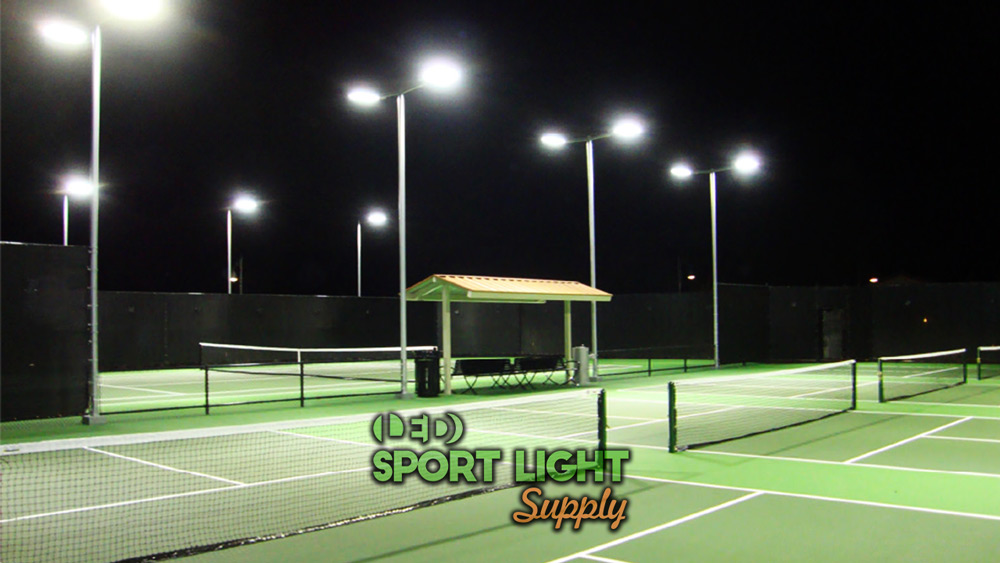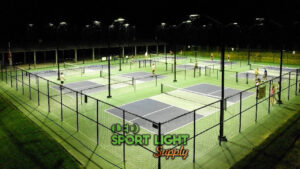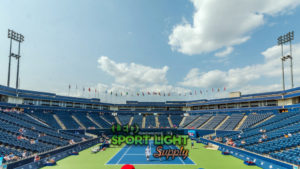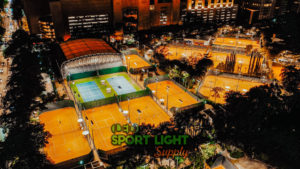What is tennis court lighting layout? It is basically the arrangement of the lighting inside the tennis court. No matter you are installing the new lamps or retroffiting the existing tennis court lights such as metal halide, halogen of HPS lamps, having a good lighting layout can improve brightness and light uniformity of tennis court. In this page, you will learn the different tennis court arrangements as well as how to layout them.
Objectives of Making a Tennis Court Light Layout Plan
1. Sufficient brightness for tennis play
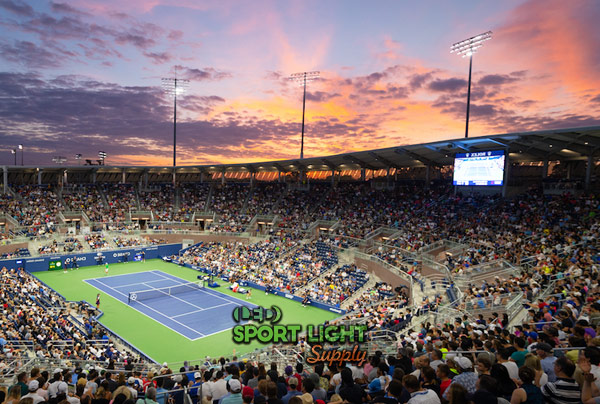 The most important function of tennis court lighting is to provide the adequate illumination on the sports field, so the player can clearly see the borders and the fast-moving tennis ball. Depending on the applications, we can have different brightness (lumens) on the tennis court. For instance, if your tennis court is for residential use, we can have around 200 to 350 lux. It is bright enough for recreational play, but not producing much glare to the neighbor. Thus, it is not always brighter the better for the backyard or outdoor tennis court lighting layout.
The most important function of tennis court lighting is to provide the adequate illumination on the sports field, so the player can clearly see the borders and the fast-moving tennis ball. Depending on the applications, we can have different brightness (lumens) on the tennis court. For instance, if your tennis court is for residential use, we can have around 200 to 350 lux. It is bright enough for recreational play, but not producing much glare to the neighbor. Thus, it is not always brighter the better for the backyard or outdoor tennis court lighting layout.
If you need the lighting layout for commercial or professional tennis arena or stadium, the required lighting illuminance will raise to above 500 lux, or even 1000 lux depending on the class of the competition, says class I, class II or class III tennis court. For class I, the lighting arrangement requires 500 lux+. For class II, it requires around 300 lux, and class II needs 200 lux.
See also: IES & USTA lighting standard
If you don’t have time to design and plan the lighting in tennis court, please feel free to drop us a message to Sport Light Supply. Our sports lighting engineers will recommend the best lighting layout plan for different types of tennis fields.
2. Good lighting uniformity
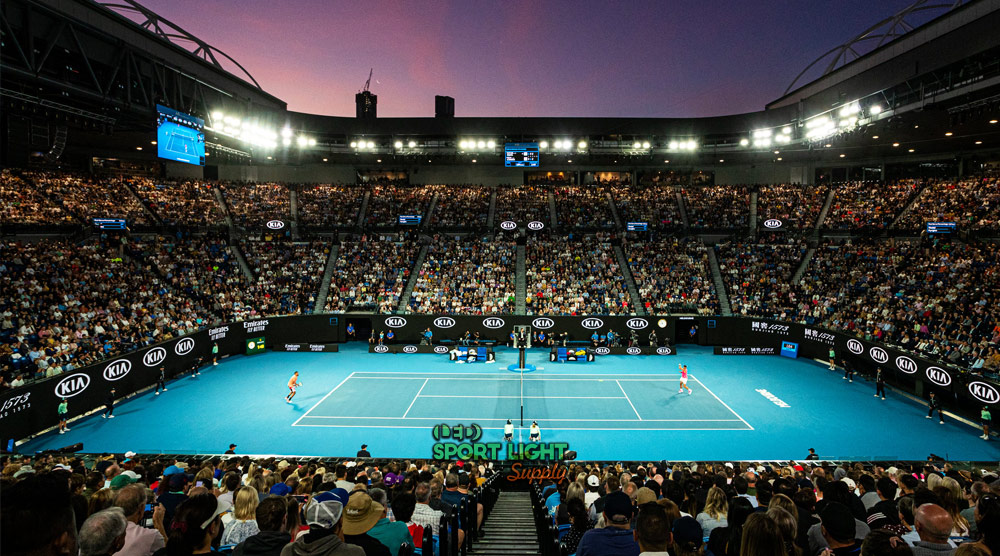
When planning the layout of tennis court lights, we need to think of the lighting uniformity as well. If the light beam is evenly distributed in the court, we can say it has a high light uniformity. It is basically a scale from 0 (min) to 1 (max). Its calculation is based on the ratio between the minimum lux to average lux, or minimum lux to maximum lux in the specific area. A good layout plan should have around 0.7. This value can be found in the DIALux photometric report.
How to increase the lighting uniformity of tennis court? By making use of the LED lights having different power and beam angles, it is possible for us to achieve the lighting uniformity up to 0.8 to 0.9.
3. Glare and spill lights
When design the lighting layout, we also need to consider the glare inside and outside tennis court. Why? Inside the tennis court, the player’s eyes will be uncomfortable and even irritated if the glare is too strong. Outside the court, the light pollution will increase if the glare is too high. Thus, we should control the glare rating (GR) below 50, so as to minimize the spill lights in the evening. Some contractors or clients may require the glare rating <50 or even <40 to have the better overall arrangement of the tennis court lamps.
4. Reduce the tennis court lighting cost
Getting a good tennis court lighting layout can save your time and money! By optimizing the lighting arrangement, such as power, luminous efficacy, beam angle and pointing direction, we can minimize the number of luminaires on the tennis court light pole. In generally, 4 to 8 lights would be adequate for recreational tennis field. Having a good planning beforehand can definitely save the lamp cost and installation cost.
5. Life span of the lighting fixtures
LED, halogen, metal halide or HPS tennis court lights? If you wish to reduce the running cost and subsequent maintenance cost, it is better to have LED lights. This is because LED has the life span of 80,000 to 100,000 hours, which is around 5x to 10x higher than those conventional light sources such as halogen or metal halide lamps. Using LED is more environmentally friendly as well because we don’t need to replace the lamps so frequently.
Outdoor Tennis Court Lighting Layout
How to arrange the tennis court light poles and luminaires? There are several standard lighting layouts adopted by tennis court lighting contractors, such as 4-pole, 6-pole, 8-pole and 9-pole layouts. For each design, they have different characteristic, advantages and limitations. In this section, we are going to discuss the layout for outdoor or indoor tennis courts. Let’s explore.
a. 4-pole layout (outdoor)
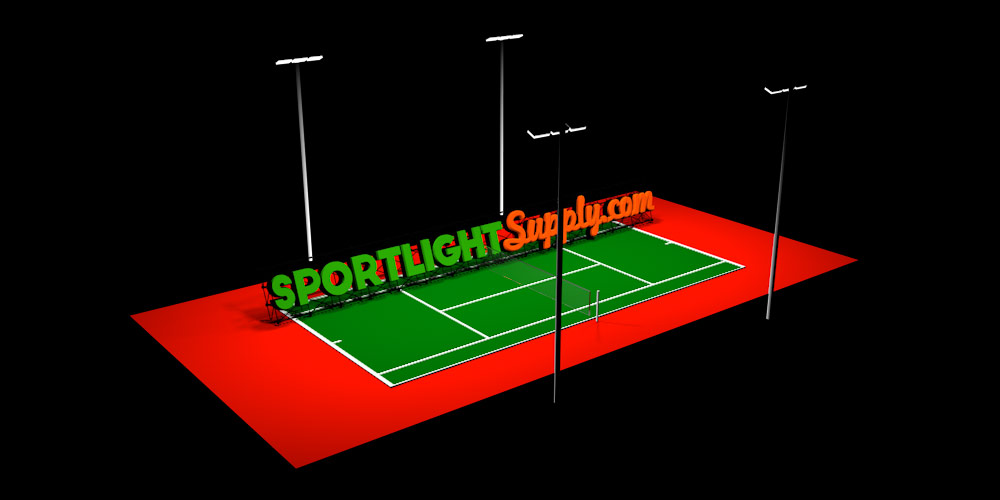
4-pole layout means each tennis court has 4 light poles. There are 2 poles on each long sideline of the outdoor tennis court. Why don’t we put the poles near the base line? There are two reasons to explain this. First, the light will need to travel to a longer distance to reach the tennis court net, and thus the brightness is lower at the center of the tennis court. Second, the glare would be significantly increased as it is easier for the tennis players to look at the lights at the short side.
Where should the tennis court light pole be? Right, another vital consideration of the tennis court layout is the location of the pole. They can be placed near the level of service line, and at the distance of 1.5m to 3m of the double sideline.
Then, it is the best to have 2 lamps on each tennis court light pole. This is because this layout can have the better lighting coverage on the court, so the tennis player can see the balls and opponents clearly.
The merit of this design is that we can use a smaller number of poles and save space. As for the limitation, the pole height should be a little higher to ensure a good lighting uniformity, and this may increase the spill light.
b. 6-pole layout (outdoor)
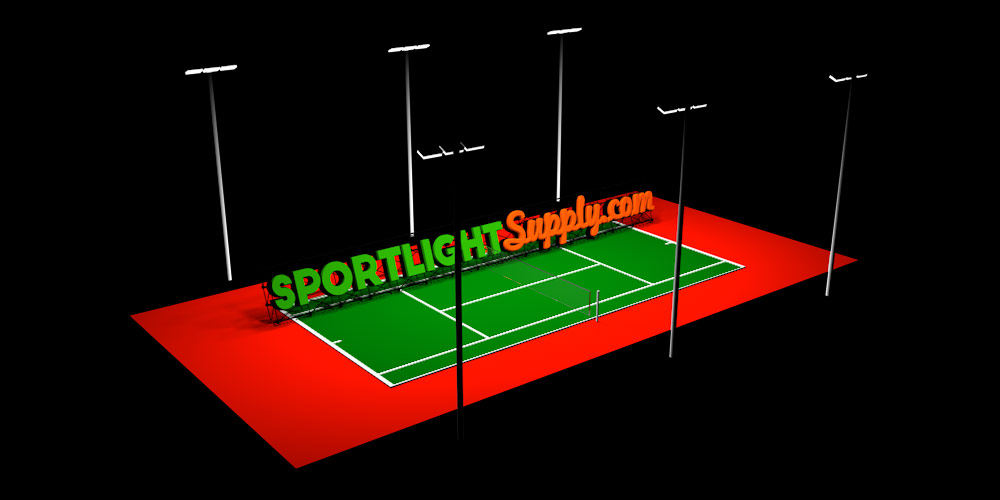
Another standard layout for outdoor tennis court is 6-pole arrangement. On top of the 4-pole design, we have two additional light poles at the center. So, there are 3 poles on each long side. The typical way is to install 1 to 2 lamps on each pole to give the bright illumination for tennis players and spectators.
Why do we need 6-pole layout for outdoor tennis court? The purpose of this arrangement is to eliminate the shadow on the tennis court. It is because the light beam is coming from 6 different directions instead f 4, so the shadow of the player can be minimized, no matter they are hitting tennis strokes in service box or double alley. In addition, we can reduce the overall power required as each light pole is responsible for a smaller area, so the light loss is reduced.
However, 6-pole layout has its drawback. For instance, the cost of light pole would be higher as there are 2 more poles in the court when compared to 4 poles. Also, we would expect that the wiring and installation cost is higher.
4-pole vs 6-pole tennis court: which is better?
If you are looking for new light pole layout and doesn’t have much budget, it is recommended to adopt the 4-pole tennis court lighting layout, as this pole arrangement can minimize the cost of light pole and installation cost. By selecting the quality LED luminaires and getting a good lighting design, we can also achieve the bright and uniform illumination.
c. 9-pole layout (adjoining outdoor tennis courts)
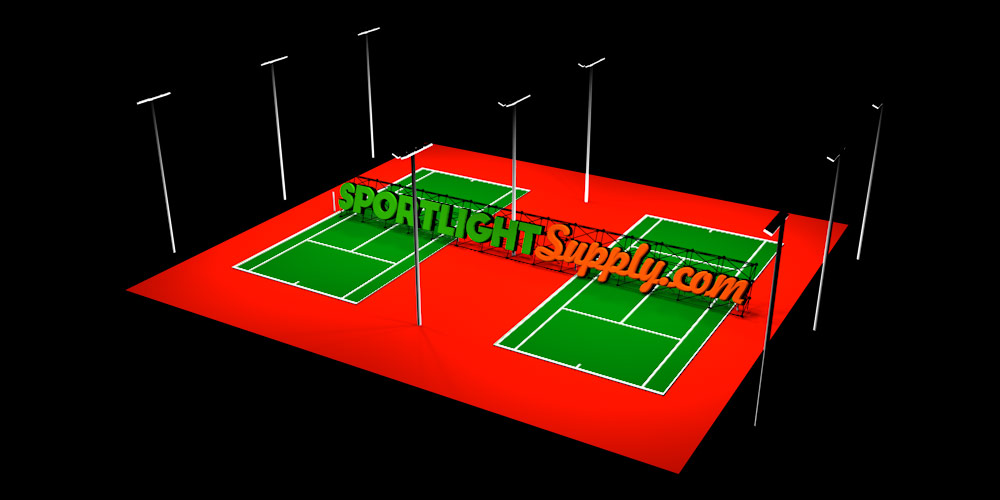
If you would like to build a double tennis court (side-by-side), you will probably need to adopt 9-pole arrangement. The light pole layout is 3×3, which means there are 3 poles on the double sideline of tennis court A, 3 poles in the adjoining area of the court A & B, and 3 poles on the double sideline of court B. So, the court A & B share the 3 poles between them. In this planning, we can minimize the number of light poles and thus the installation cost of tennis court lighting.
However, we need to make sure the light poles in the middle can tolerate the weight of the luminaires and there are 2x more lamps. To reduce the risk, we may select LED lighting because of its light weight.
Indoor Tennis Court Lighting Layout
How about the lighting layout for indoor tennis court? It is a completely different story as we don’t need poles indoor. Instead, we are going to hang the luminaires on ceiling. In fact, there are different types of lighting arrangement.
a. Gypsophila lighting layout
We are not going to scare you with this compilated name. In fact, the Gypsophila lighting layout is very common for indoor tennis court. In this arrangement, the lights are hung on the beams, which form several “strips”. Then, the strips are aligned to the sidelines of the tennis court. The lamp (illumination) surface and the floor should be perpendicular to each other.
Pros & Cons
Since there are countless light source on the ceiling, this arrangement can significantly reduce the shadow created by the tennis court lights.
However, as we need to use higher number of lights, the room temperature may increase a lot if the lighting efficiency of the lamp is low. To solve this, we may adopt LED lights that has the high energy efficiency, so we can reduce the power consumption of the lights to give brighter illumination.
b. Horse-riding lighting layout
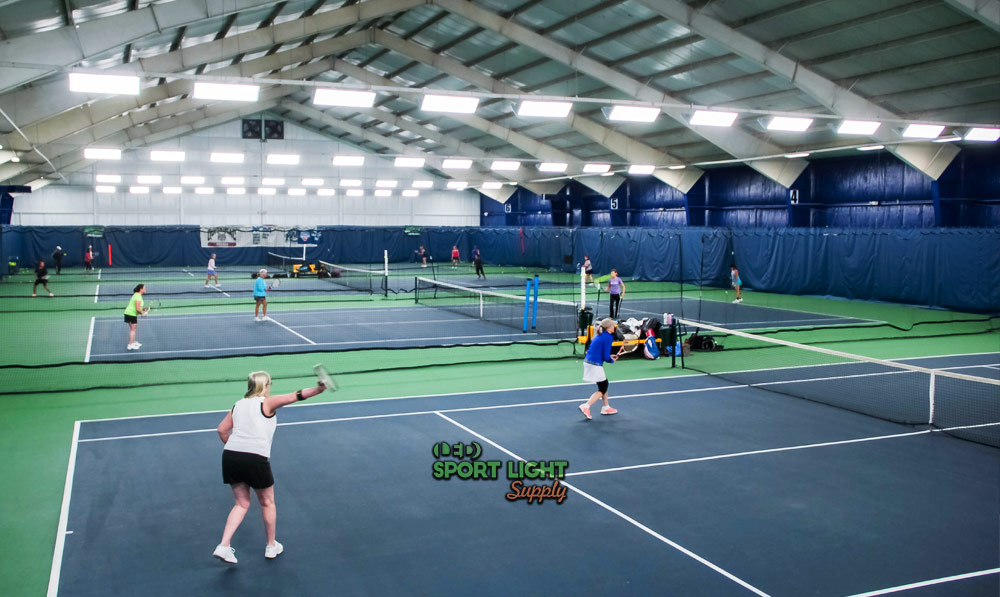
What is horse-riding sports lighting layout? As its name suggested, the lamp is like the horse rider – two luminaires are hung at the opposite directions. In this layout, the lights are pointing to the indoor tennis court obliquely.
Pros & Cons
Since the lamps are pointing to two directions, we can reduce the number of beams and thus reduce the installation cost. Also, we can use lesser number of lamps.
Yet, since we are using the smaller beam angle in this setting, the lamp may produce higher glare. The solution is to increase the height of the beam.
c. Reflection arrangement (indirect lighting)
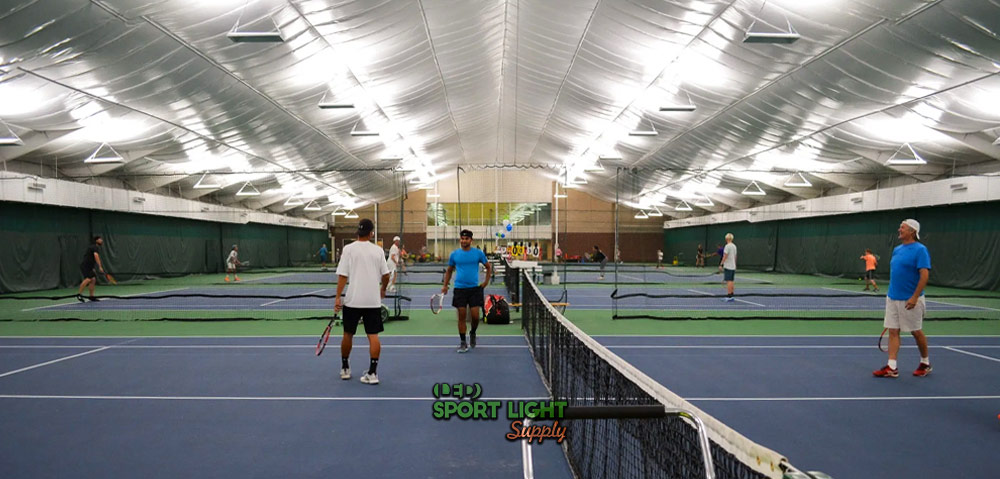
If you need to maximize the lighting uniformity, we can consider having the reflection arrangement for indoor tennis court. Unlike pointing the lamps downward, now we are projecting all the lights upward and use the reflected lights of the roof to light up the tennis court. The roof would act like as a huge “reflector”. This lighting layout is the most comfortable for tennis players.
However, we will need more lighting fixtures as there is significant light loss during the reflection. If the ceiling is too high, we will even need extra lights, which increase the overall project cost. Besides, the application of reflection lighting layout is quite limited as it is only suitable for the tennis courts having the flat ceiling.
If further assistance is needed, please feel free to drop a message to us at email info@sportlightsupply.com, our lighting engineers will reply to you very soon.

